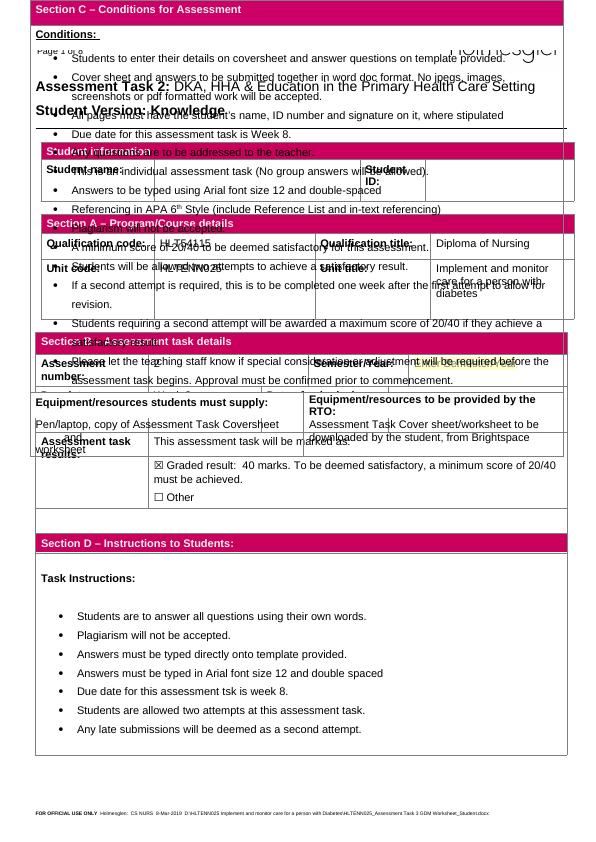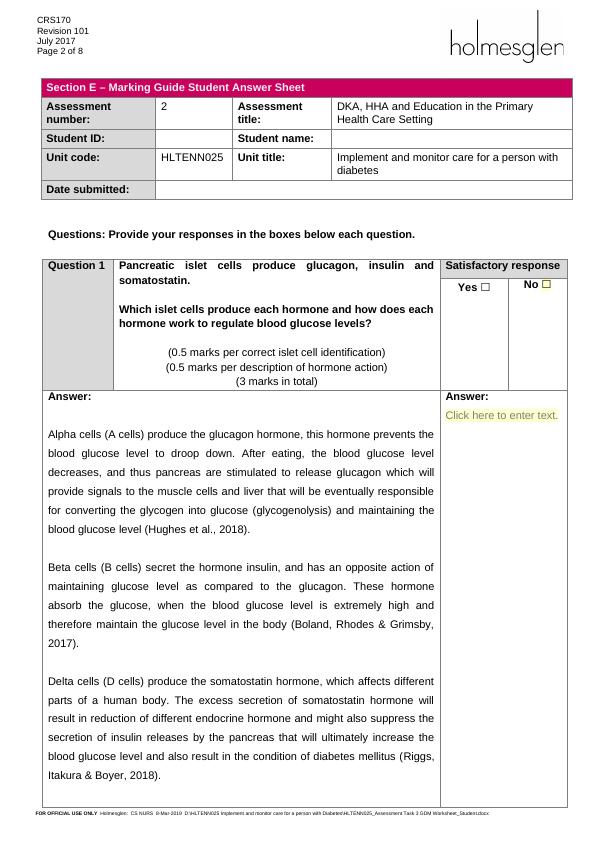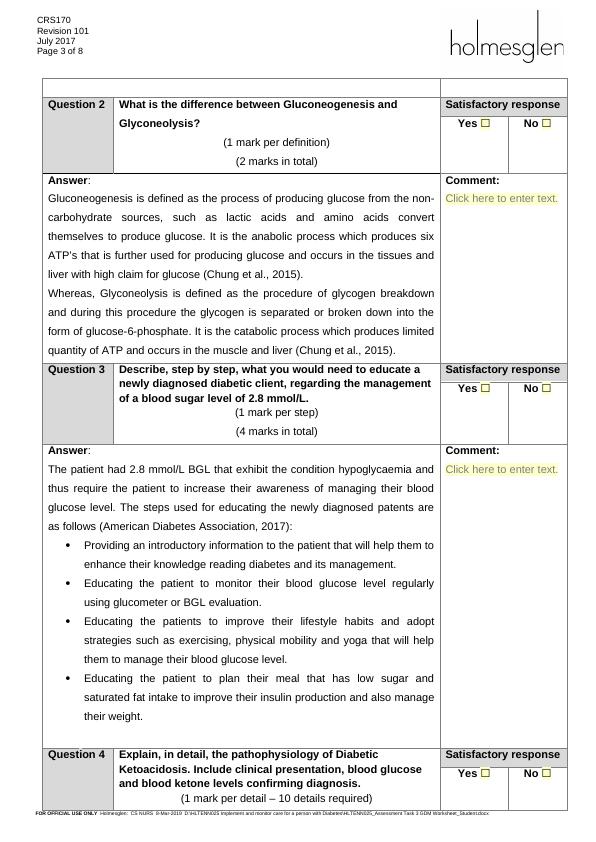DKA, HHA & Education in the Primary Health Care Setting
Added on 2022-11-25
8 Pages2923 Words168 Views
CRS170
Revision 101
July 2017
Page 1 of 8
Assessment Task 2: DKA, HHA & Education in the Primary Health Care Setting
Student Version: Knowledge
Student information
Student name: Student
ID:
Section A – Program/Course details
Qualification code: HLT54115 Qualification title: Diploma of Nursing
Unit code: HLTENN025 Unit title: Implement and monitor
care for a person with
diabetes
Section B – Assessment task details
Assessment
number:
2 Semester/Year: Enter Semester/Year
Due date: Week 8 Date of submission:
Assessment task
results:
This assessment task will be marked as:
☒ Graded result: 40 marks. To be deemed satisfactory, a minimum score of 20/40
must be achieved.
☐ Other
Section D – Instructions to Students:
Task Instructions:
Students are to answer all questions using their own words.
Plagiarism will not be accepted.
Answers must be typed directly onto template provided.
Answers must be typed in Arial font size 12 and double spaced
Due date for this assessment tsk is week 8.
Students are allowed two attempts at this assessment task.
Any late submissions will be deemed as a second attempt.
FOR OFFICIAL USE ONLY Holmesglen: CS NURS 8-Mar-2019 D:\HLTENN025 Implement and monitor care for a person with Diabetes\HLTENN025_Assessment Task 3 GDM Worksheet_Student.docx
Section C – Conditions for Assessment
Conditions:
Students to enter their details on coversheet and answer questions on template provided.
Cover sheet and answers to be submitted together in word doc format. No jpegs, images,
screenshots or pdf formatted work will be accepted.
All pages must have the student’s name, ID number and signature on it, where stipulated
Due date for this assessment task is Week 8.
Any questions are to be addressed to the teacher.
This is an individual assessment task (No group answers will be allowed).
Answers to be typed using Arial font size 12 and double-spaced
Referencing in APA 6th Style (include Reference List and in-text referencing)
Plagiarism will not be accepted.
A minimum score of 20/40 to be deemed satisfactory for this assessment.
Students will be allowed two attempts to achieve a satisfactory result.
If a second attempt is required, this is to be completed one week after the first attempt to allow for
revision.
Students requiring a second attempt will be awarded a maximum score of 20/40 if they achieve a
satisfactory result.
Please let the teaching staff know if special consideration or adjustment will be required before the
assessment task begins. Approval must be confirmed prior to commencement.
Equipment/resources students must supply: Equipment/resources to be provided by the
RTO:
Pen/laptop, copy of Assessment Task Coversheet
and
worksheet
Assessment Task Cover sheet/worksheet to be
downloaded by the student, from Brightspace
Revision 101
July 2017
Page 1 of 8
Assessment Task 2: DKA, HHA & Education in the Primary Health Care Setting
Student Version: Knowledge
Student information
Student name: Student
ID:
Section A – Program/Course details
Qualification code: HLT54115 Qualification title: Diploma of Nursing
Unit code: HLTENN025 Unit title: Implement and monitor
care for a person with
diabetes
Section B – Assessment task details
Assessment
number:
2 Semester/Year: Enter Semester/Year
Due date: Week 8 Date of submission:
Assessment task
results:
This assessment task will be marked as:
☒ Graded result: 40 marks. To be deemed satisfactory, a minimum score of 20/40
must be achieved.
☐ Other
Section D – Instructions to Students:
Task Instructions:
Students are to answer all questions using their own words.
Plagiarism will not be accepted.
Answers must be typed directly onto template provided.
Answers must be typed in Arial font size 12 and double spaced
Due date for this assessment tsk is week 8.
Students are allowed two attempts at this assessment task.
Any late submissions will be deemed as a second attempt.
FOR OFFICIAL USE ONLY Holmesglen: CS NURS 8-Mar-2019 D:\HLTENN025 Implement and monitor care for a person with Diabetes\HLTENN025_Assessment Task 3 GDM Worksheet_Student.docx
Section C – Conditions for Assessment
Conditions:
Students to enter their details on coversheet and answer questions on template provided.
Cover sheet and answers to be submitted together in word doc format. No jpegs, images,
screenshots or pdf formatted work will be accepted.
All pages must have the student’s name, ID number and signature on it, where stipulated
Due date for this assessment task is Week 8.
Any questions are to be addressed to the teacher.
This is an individual assessment task (No group answers will be allowed).
Answers to be typed using Arial font size 12 and double-spaced
Referencing in APA 6th Style (include Reference List and in-text referencing)
Plagiarism will not be accepted.
A minimum score of 20/40 to be deemed satisfactory for this assessment.
Students will be allowed two attempts to achieve a satisfactory result.
If a second attempt is required, this is to be completed one week after the first attempt to allow for
revision.
Students requiring a second attempt will be awarded a maximum score of 20/40 if they achieve a
satisfactory result.
Please let the teaching staff know if special consideration or adjustment will be required before the
assessment task begins. Approval must be confirmed prior to commencement.
Equipment/resources students must supply: Equipment/resources to be provided by the
RTO:
Pen/laptop, copy of Assessment Task Coversheet
and
worksheet
Assessment Task Cover sheet/worksheet to be
downloaded by the student, from Brightspace

CRS170
Revision 101
July 2017
Page 2 of 8
Section E – Marking Guide Student Answer Sheet
Assessment
number:
2 Assessment
title:
DKA, HHA and Education in the Primary
Health Care Setting
Student ID: Student name:
Unit code: HLTENN025 Unit title: Implement and monitor care for a person with
diabetes
Date submitted:
Questions: Provide your responses in the boxes below each question.
Question 1 Pancreatic islet cells produce glucagon, insulin and
somatostatin.
Which islet cells produce each hormone and how does each
hormone work to regulate blood glucose levels?
(0.5 marks per correct islet cell identification)
(0.5 marks per description of hormone action)
(3 marks in total)
Satisfactory response
Yes ☐ No ☐
Answer:
Alpha cells (A cells) produce the glucagon hormone, this hormone prevents the
blood glucose level to droop down. After eating, the blood glucose level
decreases, and thus pancreas are stimulated to release glucagon which will
provide signals to the muscle cells and liver that will be eventually responsible
for converting the glycogen into glucose (glycogenolysis) and maintaining the
blood glucose level (Hughes et al., 2018).
Beta cells (B cells) secret the hormone insulin, and has an opposite action of
maintaining glucose level as compared to the glucagon. These hormone
absorb the glucose, when the blood glucose level is extremely high and
therefore maintain the glucose level in the body (Boland, Rhodes & Grimsby,
2017).
Delta cells (D cells) produce the somatostatin hormone, which affects different
parts of a human body. The excess secretion of somatostatin hormone will
result in reduction of different endocrine hormone and might also suppress the
secretion of insulin releases by the pancreas that will ultimately increase the
blood glucose level and also result in the condition of diabetes mellitus (Riggs,
Itakura & Boyer, 2018).
Answer:
Click here to enter text.
FOR OFFICIAL USE ONLY Holmesglen: CS NURS 8-Mar-2019 D:\HLTENN025 Implement and monitor care for a person with Diabetes\HLTENN025_Assessment Task 3 GDM Worksheet_Student.docx
Revision 101
July 2017
Page 2 of 8
Section E – Marking Guide Student Answer Sheet
Assessment
number:
2 Assessment
title:
DKA, HHA and Education in the Primary
Health Care Setting
Student ID: Student name:
Unit code: HLTENN025 Unit title: Implement and monitor care for a person with
diabetes
Date submitted:
Questions: Provide your responses in the boxes below each question.
Question 1 Pancreatic islet cells produce glucagon, insulin and
somatostatin.
Which islet cells produce each hormone and how does each
hormone work to regulate blood glucose levels?
(0.5 marks per correct islet cell identification)
(0.5 marks per description of hormone action)
(3 marks in total)
Satisfactory response
Yes ☐ No ☐
Answer:
Alpha cells (A cells) produce the glucagon hormone, this hormone prevents the
blood glucose level to droop down. After eating, the blood glucose level
decreases, and thus pancreas are stimulated to release glucagon which will
provide signals to the muscle cells and liver that will be eventually responsible
for converting the glycogen into glucose (glycogenolysis) and maintaining the
blood glucose level (Hughes et al., 2018).
Beta cells (B cells) secret the hormone insulin, and has an opposite action of
maintaining glucose level as compared to the glucagon. These hormone
absorb the glucose, when the blood glucose level is extremely high and
therefore maintain the glucose level in the body (Boland, Rhodes & Grimsby,
2017).
Delta cells (D cells) produce the somatostatin hormone, which affects different
parts of a human body. The excess secretion of somatostatin hormone will
result in reduction of different endocrine hormone and might also suppress the
secretion of insulin releases by the pancreas that will ultimately increase the
blood glucose level and also result in the condition of diabetes mellitus (Riggs,
Itakura & Boyer, 2018).
Answer:
Click here to enter text.
FOR OFFICIAL USE ONLY Holmesglen: CS NURS 8-Mar-2019 D:\HLTENN025 Implement and monitor care for a person with Diabetes\HLTENN025_Assessment Task 3 GDM Worksheet_Student.docx

CRS170
Revision 101
July 2017
Page 3 of 8
Question 2 What is the difference between Gluconeogenesis and
Glyconeolysis?
(1 mark per definition)
(2 marks in total)
Satisfactory response
Yes ☐ No ☐
Answer:
Gluconeogenesis is defined as the process of producing glucose from the non-
carbohydrate sources, such as lactic acids and amino acids convert
themselves to produce glucose. It is the anabolic process which produces six
ATP’s that is further used for producing glucose and occurs in the tissues and
liver with high claim for glucose (Chung et al., 2015).
Whereas, Glyconeolysis is defined as the procedure of glycogen breakdown
and during this procedure the glycogen is separated or broken down into the
form of glucose-6-phosphate. It is the catabolic process which produces limited
quantity of ATP and occurs in the muscle and liver (Chung et al., 2015).
Comment:
Click here to enter text.
Question 3 Describe, step by step, what you would need to educate a
newly diagnosed diabetic client, regarding the management
of a blood sugar level of 2.8 mmol/L.
(1 mark per step)
(4 marks in total)
Satisfactory response
Yes ☐ No ☐
Answer:
The patient had 2.8 mmol/L BGL that exhibit the condition hypoglycaemia and
thus require the patient to increase their awareness of managing their blood
glucose level. The steps used for educating the newly diagnosed patents are
as follows (American Diabetes Association, 2017):
Providing an introductory information to the patient that will help them to
enhance their knowledge reading diabetes and its management.
Educating the patient to monitor their blood glucose level regularly
using glucometer or BGL evaluation.
Educating the patients to improve their lifestyle habits and adopt
strategies such as exercising, physical mobility and yoga that will help
them to manage their blood glucose level.
Educating the patient to plan their meal that has low sugar and
saturated fat intake to improve their insulin production and also manage
their weight.
Comment:
Click here to enter text.
Question 4 Explain, in detail, the pathophysiology of Diabetic
Ketoacidosis. Include clinical presentation, blood glucose
and blood ketone levels confirming diagnosis.
(1 mark per detail – 10 details required)
Satisfactory response
Yes ☐ No ☐
FOR OFFICIAL USE ONLY Holmesglen: CS NURS 8-Mar-2019 D:\HLTENN025 Implement and monitor care for a person with Diabetes\HLTENN025_Assessment Task 3 GDM Worksheet_Student.docx
Revision 101
July 2017
Page 3 of 8
Question 2 What is the difference between Gluconeogenesis and
Glyconeolysis?
(1 mark per definition)
(2 marks in total)
Satisfactory response
Yes ☐ No ☐
Answer:
Gluconeogenesis is defined as the process of producing glucose from the non-
carbohydrate sources, such as lactic acids and amino acids convert
themselves to produce glucose. It is the anabolic process which produces six
ATP’s that is further used for producing glucose and occurs in the tissues and
liver with high claim for glucose (Chung et al., 2015).
Whereas, Glyconeolysis is defined as the procedure of glycogen breakdown
and during this procedure the glycogen is separated or broken down into the
form of glucose-6-phosphate. It is the catabolic process which produces limited
quantity of ATP and occurs in the muscle and liver (Chung et al., 2015).
Comment:
Click here to enter text.
Question 3 Describe, step by step, what you would need to educate a
newly diagnosed diabetic client, regarding the management
of a blood sugar level of 2.8 mmol/L.
(1 mark per step)
(4 marks in total)
Satisfactory response
Yes ☐ No ☐
Answer:
The patient had 2.8 mmol/L BGL that exhibit the condition hypoglycaemia and
thus require the patient to increase their awareness of managing their blood
glucose level. The steps used for educating the newly diagnosed patents are
as follows (American Diabetes Association, 2017):
Providing an introductory information to the patient that will help them to
enhance their knowledge reading diabetes and its management.
Educating the patient to monitor their blood glucose level regularly
using glucometer or BGL evaluation.
Educating the patients to improve their lifestyle habits and adopt
strategies such as exercising, physical mobility and yoga that will help
them to manage their blood glucose level.
Educating the patient to plan their meal that has low sugar and
saturated fat intake to improve their insulin production and also manage
their weight.
Comment:
Click here to enter text.
Question 4 Explain, in detail, the pathophysiology of Diabetic
Ketoacidosis. Include clinical presentation, blood glucose
and blood ketone levels confirming diagnosis.
(1 mark per detail – 10 details required)
Satisfactory response
Yes ☐ No ☐
FOR OFFICIAL USE ONLY Holmesglen: CS NURS 8-Mar-2019 D:\HLTENN025 Implement and monitor care for a person with Diabetes\HLTENN025_Assessment Task 3 GDM Worksheet_Student.docx

End of preview
Want to access all the pages? Upload your documents or become a member.
Related Documents
Assignment on Diploma of Nursing Unit Codelg...
|7
|2734
|173
DKA, HHA & Education in Primary Health Care Settinglg...
|6
|2129
|332
Conditions for Assessmentlg...
|7
|2977
|265
Assessment Task 1: Gestational Diabetes Mellitus Tutorial Worksheet Student Version: Gestational Diabetes Mellituslg...
|9
|2631
|362
CRS170 Revision 101 July 2017 Page 1 of 11.lg...
|11
|3913
|72
Performing Nursing Interventions for a Person with Complex Needslg...
|22
|4677
|58